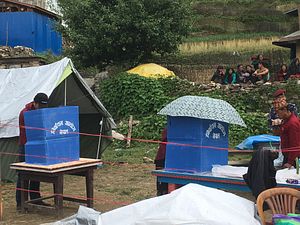LAPRAK, GORKHA, NEPAL — Tulsi Gurung, 35, woke up at dawn on May 13 to board a bus at Kathmandu’s Naya Bus Park with his wife, Ri Maya Gurung, 32, and their daughter Rebika Gurung, 4. The bus park was crowded despite the early hour; passengers awaiting departure loitered with glasses of tea and hawkers announced bottled water and pustakari, a Nepali sweet, for sale. Tulsi and his family had come to catch a bus to their village of Laprak in Gorkha District, just kilometers from the epicenter of the April 2015 earthquake that killed nearly 9,000 people and left over 750,000 families homeless. Tulsi, a trekking guide, had recently completed a climb of Tukche Peak in the Annapurna region of the country. Ri Maya usually stays in the village, where she lives in a temporary shelter with the children and farms potatoes and buckwheat, but she had brought Rebika to the capital city several days earlier to treat an eye infection. The family was in a hurry to return home to vote in local elections — the country’s first since 1997.
For many Nepalis, the election represents their first chance to choose local representatives responsible for governance and development, and to influence the ongoing earthquake recovery process.
“I’m 35 years old,” said Tulsi, cradling Rebika in his lap on the bus. “This is the first time in my life I’ve been able to vote in my village.” He explained that he planned to vote for a distant cousin who is running for chairperson of his rural municipality. “He’s the sort of person who when he speaks, everyone in the room becomes silent. Many people become corrupt once they get elected, but if he wins, we’ll see what he can do.”
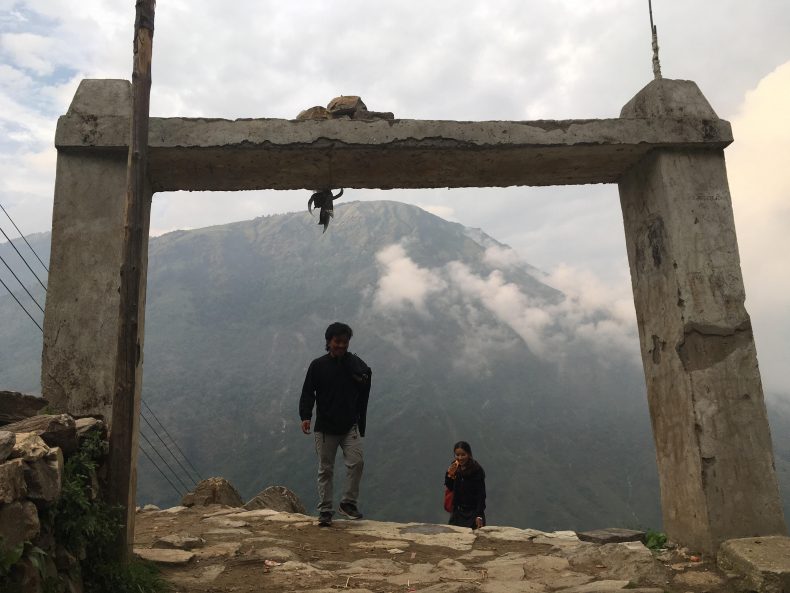
Tulsi Gurung, Ri Maya Gurung, and Rebika en route to their village, Laprak, to take part in elections.
Nepal has been through much in the past 20 years, since the last local elections were held. A Maoist insurgency gripped the countryside from 1996-2006, and local elections were called off in 2002 amid security concerns; villages like Laprak have been administered by centrally appointed bureaucrats ever since. The Maoist insurgency ended in a 2006 peace agreement that led to the end of the country’s constitutional monarchy and the declaration of a secular, federal republic. Constituent assemblies were elected in 2008 and again in 2013 to draft a new constitution, but local-level elections were put off to focus on the drafting process and address divisions over how to divide power between the northern hills and mountains on one hand, and the southern plains on the other. (Due to the ongoing nature of these disputes, this year’s local elections in the plains have been postponed until mid-June.)
In September 2015, the new constitution was finally ratified, creating a federal state structure intended to decentralize power from Kathmandu to seven newly-created provinces and re-arranged local government units. However, by this time the country was reeling from the effects of the earthquake. Lacking locally elected representatives, much of the reconstruction process began in a centralized manner, overseen by the National Reconstruction Authority (NRA) and implemented by ministries based in the capital.
On board Tulsi’s family’s bus, the seats and aisles were packed with people returning to their villages to vote. Passengers with seats held children – their own and strangers’ – on their laps to make more room for those who had to stand. The conductor handed out plastic bags for vomiting to carsick passengers as the vehicle ascended into the hills and the road became ever more twisty and turny.
At 5 pm, the bus reached the end of the navigable road. Pre-monsoon rains had drenched the dirt road ahead, making it too muddy to go further. The remaining Laprak-bound passengers dismounted and began to walk into the night, reaching the town of Barpak, lower down on the same hill as Laprak, at 8 pm, where they checked into a local lodge. The next morning, Tulsi and Ri Maya got up at dawn and walked the remaining four hours to Laprak, taking turns carrying Rebika and their belongings along stony paths and through wildflower-dotted pastures.
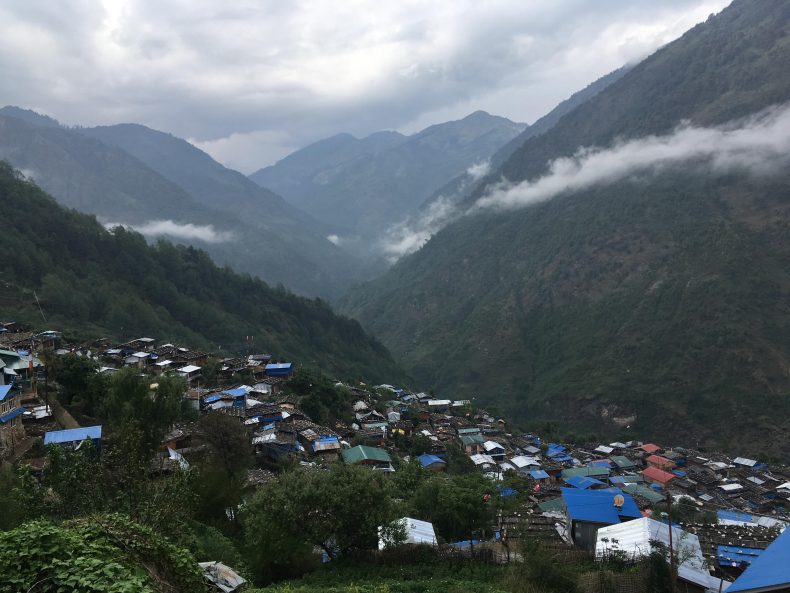
Laprak. Photo by Peter Gill.
Upon reaching home, Ri Maya’s two older children, Ritu, 7, and Ritam, 14, who had been staying with their grandmother, greeted them outside the family’s temporary shelter. The shelter is approximately 7 meters by 2.5 meters, and is made from wood and corrugated tin. The family has already endured two cold winters living in the cramped space.
Throughout most of Nepal’s earthquake-affected regions, houses are being rebuilt by families using government grants provided in three tranches, disbursed as homeowners demonstrate progress using prescribed building guidelines. But progress has been slow for a variety of reasons. There has been political infighting over control of resources at the central level, and difficulties in transportation of materials over rough terrain. Lack of manpower in villages has created delays (according to the census, nearly two million Nepalis are working abroad, mostly in India, the Middle East and Southeast Asia), as have time-consuming requirements for beneficiaries to receive grants, including opening a bank account and acquiring various documents from government offices. According to the NRA, reconstruction grant agreements have been signed with over 575,000 households to provide Rs. 300,000 (roughly $2,900) to each, but so far less than 13,000 households have received more than the initial tranche of Rs. 50,000. Foreign donor support is mostly limited to providing technical assistance, although roughly 17,500 households’ reconstruction is being financed by partner organizations, according to the Housing Recovery and Reconstruction Platform (HRRP), a donor coordination platform co-led by the International Organization for Migration and UN-Habitat.
The housing reconstruction process is slightly different in Laprak, which received considerable public attention because of its proximity to the earthquake epicenter and because of its popularity as a trekking destination. (Many children here speak a smattering of English and French learnt from tourists, and many young men, like Tulsi, work in the trekking industry.) An association of Nepalis living abroad, the Non-Resident Nepali Association, assumed responsibilities for financing housing, and the Nepal Army is undertaking the physical reconstruction process in Laprak. But as with areas where housing reconstruction is financed by the government, many people are disappointed with the rate of progress so far. Although the army has laid the foundations of most houses, none have yet been completed, and village residents continue to live in temporary shelters.
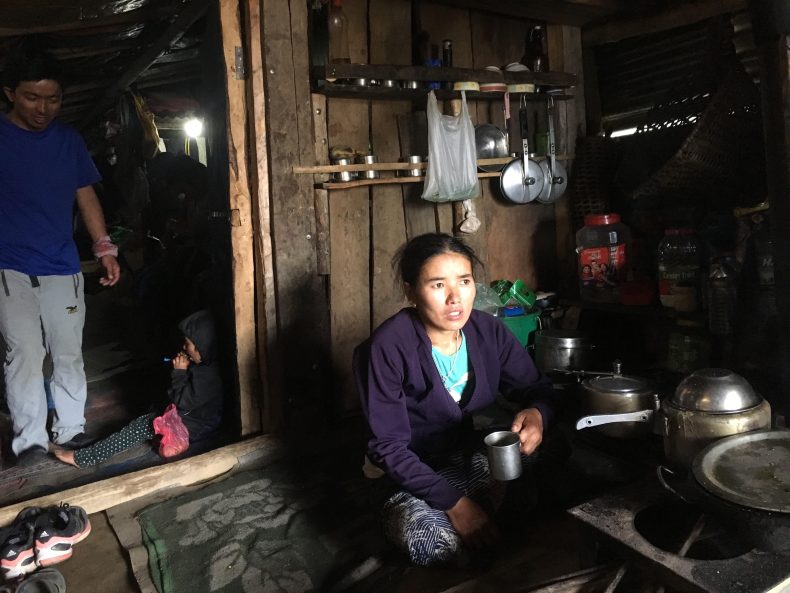
Ri Maya Gurung at her stove in the family’s temporary shelter in Laprak. Photo by Peter Gill.
After a quick lunch of potatoes and mustard greens in their shelter, Tulsi and Ri Maya walked another 15 minutes to their polling station, where most of the village had already gathered. Along the way, they passed other homes where political party flags fluttered outside. Voters queued around the soccer field of the old village school, which the earthquake reduced to a pile of rubble. (Luckily, the earthquake happened on a Saturday, so no children were there, though 19 people were killed in the village. Students now study in temporary learning centers set up with support from a French organization.) Hundreds of villagers who finished voting milled about on the edge of the soccer field, while others attended one of four feasts at nearby houses hosted by the major parties fielding candidates, offering chicken, mutton, and local beer. This get-out-the-vote strategy is technically against the Election Commission’s rules, but is common in Nepal nonetheless.
Ri Maya quickly got in the line to vote. “Whichever party wins, I hope they will provide job skills trainings for the poor, and women like me,” she said. She added that she hoped to buy a sewing machine if the local government provides a credit scheme.
Another woman in line, Sarita Sunar, 23, explained why she was voting: she lives in a small community of Dalits (so-called “untouchable” castes) on the edge of the village, and has to walk half an hour to the nearest tap to fetch water; she hoped her candidate would install more water taps.
Ten police officers guarded the polling area. One, who declined to give his name, said that there had been no significant disturbances to the electoral process. “Everyone knows each other here. The elections are like a contest between brothers,” he offered by way of explanation.
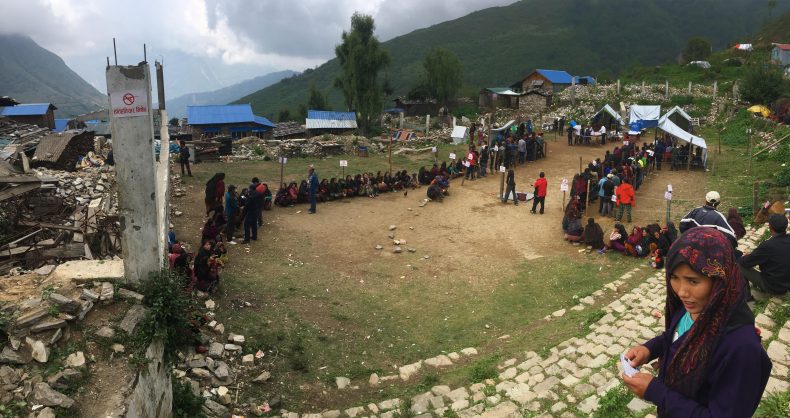
The polling station in Laprak. Photo by Peter Gill.
Several political candidates stood nearby the election booths. Santosh Gurung, 55, Tulsi’s cousin and the Nepali Congress party’s candidate for municipality chairperson, looked on as voters huddled underneath umbrellas as it began to drizzle.
“The earthquake set everyone back,” he said. “What we need now is a plan for economic prosperity. We have seven rivers in this area that can be used for hydropower. If we can harness the power of just four of these rivers, that could end load-shedding [power cuts] and bring a lot of prosperity.” He explained that if elected, he would expand the local road network, plant trees to stop erosion (the area is prone to catastrophic landslides), promote tourism by providing training and credit for families to start village home-stays, and even study the feasibility of providing ultra-light aircraft tours locally.
Asha Gurung, 28, the Maoist candidate for vice-chairperson, stood nearby, also observing the polling process. When prodded, she offered a similar set of plans around electricity, tourism, and agriculture. She added that as a young person, she would make special efforts to expand employment opportunities for youth.
According to Bhaskar Gautam, a Kathmandu-based political scientist at the NGO Governance Facility, it is not unusual for candidates to campaign on similar promises, since patronage networks are really what are most important in campaigning. “The state has a very central role in terms of opportunities and access to resources. Especially for people in rural areas, it is very important to participate in elections because if there is any problem, it is important for them to know somebody, whether they need legal help or in some other kind of official process.”
Siobhan Kennedy, Recovery Advisor at HRRP, said that the election of local officials could help earthquake-affected people gain better access to government resources. “Generally, the elections are seen as a positive step as the local officials will play a very important role in supporting the recovery process. [Local officials] have been very involved in the reconstruction supporting enrollment, grievance registration…and providing information and support to households.”
At 5 pm, someone blew a whistle at the Laprak polling station to announce that the polls were closed. The crowd watched as the ballot boxes were sealed and carried off by a delegation to the nearby village of Gumda for counting.
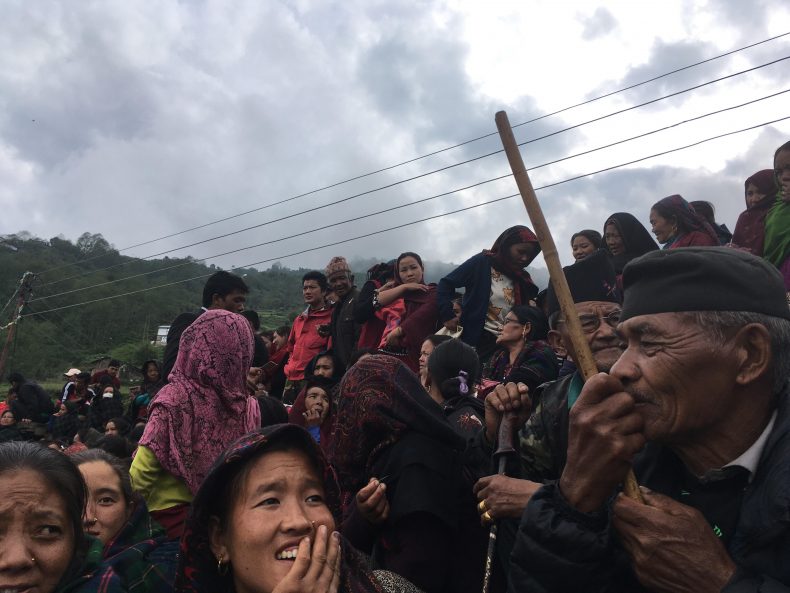
Voters await the close of polls in Laprak. Photo by Peter Gill.
According to Dil Bahadur Chhetri, the election official in charge of the Laprak polling station, over 80 percent of 1,442 individuals registered to vote in the village cast their ballots. The central Election Commission later reported that 70 percent of registered voters cast ballots nationwide, a high rate by global standards. According to the National Human Rights Commission, which provided monitoring across the country, there were scattered incidents of violence, including at least one death related to the election in Dolakha district, but overall the elections were largely peaceful.
By Wednesday night, Santosh Gurung, the Nepali Congress candidate, had emerged as the winner of the election for Laprak’s municipality’s chairperson. Ballots are still being counted elsewhere around the country, though it appears Communist Party of Nepal (United Marxist-Leninist) and Nepali Congress held leads in most mayoral and chairperson races, followed by the Communist Party of Nepal (Maoist-Center).
On the night of the election, sitting by the wood stove in his dim shelter, Tulsi Gurung said that he felt very happy to have cast his vote for the Nepali Congress candidate, Santosh Gurung. When asked if he had voted for Santosh because of his kin relationship, Tulsi smiled, and said that that was part of it. But he added that the candidate had a long history of serving others in the village, and he thought his seniority would enable him to act effectively in the public interest.
The next morning, Tulsi and Ri Maya walked a few minutes uphill to deliver a bag of apples they had brought from Kathmandu to an elderly person’s shelter set up after the earthquake. The shelter was not much larger than their own, and housed one man and three elderly women without younger family members to take care of them in the village.
Has Maya Gurung, 70, who lost an eye to an infection after the earthquake, sat outside warming up in the sun. She smiled when Tulsi gave her an apple, and showed the ink mark on her thumb, proof she had voted. She had walked for an hour to reach the polling station, she said. Asked why she had gone to such effort to cast her ballot, she said she wanted better services for people with disabilities in the village. She added, “I care about the future of the village.”
Peter Gill is an American freelance journalist based in Nepal.













